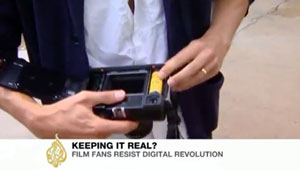Digital cameras are hugely popular, but some photographers are going back to old style film. Al Jazeera‘s John Terrett reports from New York what’s behind the nostalgia. In the digital age, who would have thought the use of real film would still be thriving?

Whereas with real film you need to load it into the camera, there is a finite number of shots and you must wait at least a couple of hours — if not days — for the film to be developed.
Well, it turns out a huge community of photographers love all that stuff, and at least two global companies are driving the hobby.
If you ask Ben Morris, a cool Englishman and a professional fashion photographer, to choose between film and digital, he’ll go for film every time.
“There is just something about it that is punchier, deeper and even flash or natural light the colours are just incomparable,” he says.
At least two global companies are helping promote it as a worldwide hobby.
“The camera’s been around for a long time,” says Liad Cohen, the boss of the U.S. division of Vienna-based Lomography.
Film as a Lifestyle
Lomography is a lifestyle company that refers to its customers as “Lomographers” rather than photographers.
It’s most famous camera is the Lomo LC-A, which was spotted in Russia by Lomo’s founders — a group of Austrian art students — who were impressed by its photographic capabilities.
That was 20 years ago and today, through its network of global stores and via the web, Lomo sells rolls of film and Cold War era Soviet and Chinese real film cameras, many of which have been jazzed up in modern eye catching colors.
“I don’t want my memories to look like digital photos,” says Cohen. “I want them to look the way they look in my mind — they’re a little bit foggy, they’re a little bit blurry sometimes.”
Film enthusiasts say they’re always keen to see how snaps turn out, but admit waiting for them to come back from the developers is part of the fun.
Says one customer: “When I come in and get my film developed it’s like a small surprise for myself.”
Another says: “I think that there’s something not creative about being about to take photos all the time like this and trashing it and trashing it and trashing it. Whereas you don’t know necessarily what you’re going to get with a real camera.”
Waiting for the film to be developed is not something the people behind The Impossible Project (TIP) — another Austrian-based company — ask of their customers.
They do ask them to scour attics, basements and bottom drawers for those iconic instant cameras from the 1970s and ’80s.
Old-Time Cameras
TIP bought the last remaining Polaroid film factory in the world — in Holland — and now sells a modern version of the film for those old-time cameras and people seem to love the results they’re getting.
Ulli Barta, who runs the U.S. division of The Impossible Project, told Al Jazeera: “To really be able to hold an image is to obviously connect and hold this very moment in your hands and this is a quality you can’t replace.”
While in TIP’s store in Manhattan, Al Jazeera’s John Terrett bumped into professional photographer Eve Stuart who was splashing out on a top-of-the-range refurbished Polaroid camera for her business.
“Beside taking my regular camera I will take the Polaroid with me everywhere and experiment and hope that I get some good shots,” she says.
“There’s such a richness of color, here.”
Back at Ben Morris’ apartment, you can tell he’s clearly sold on the idea of shooting with real film too.
But will it really last or is this just a fad?
“As long as enough people still shoot film and as long as enough people realize the benefits of shooting film over shooting digital, I see no reason at all why film would ever disappear,” he says.
And if Lomography and TIP are anything to go by, it won’t.


